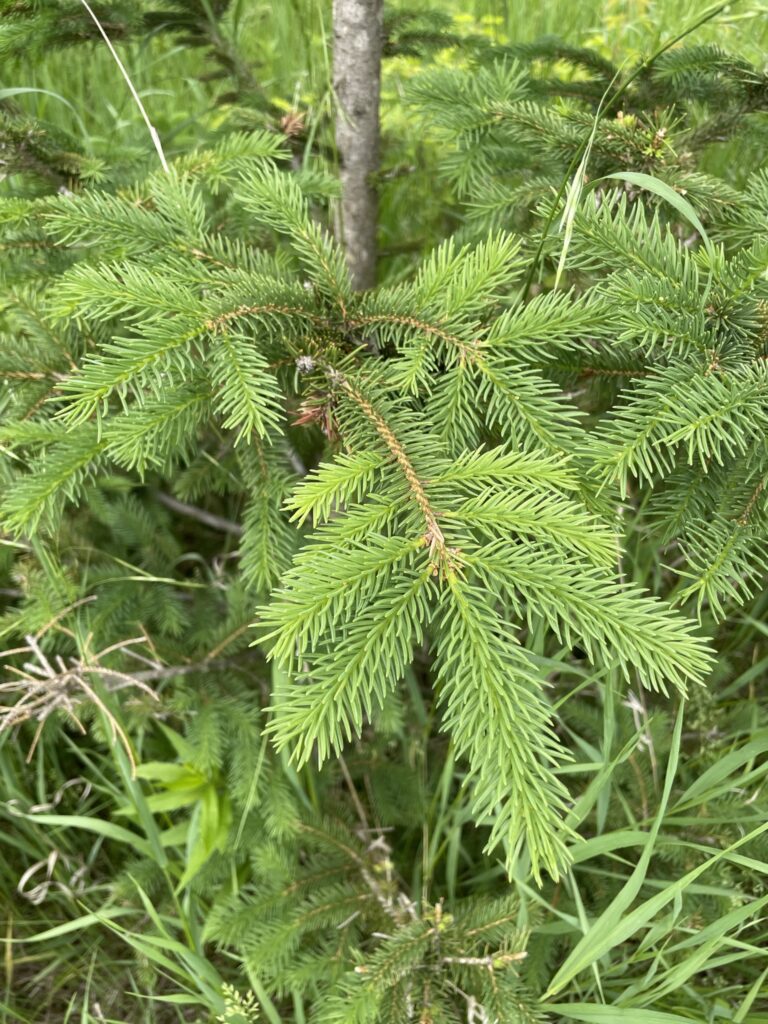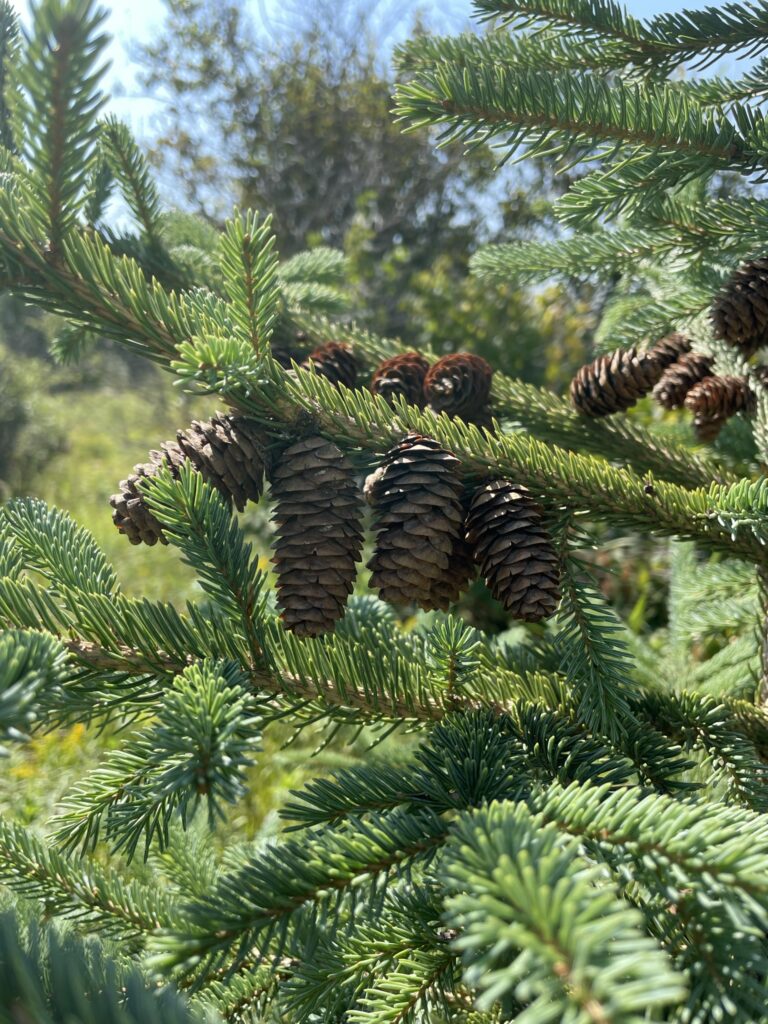
Native To State: NO
Naturally Occurring: NO
Description
Fast growing spruce with pendulous branchlets.
Occurrence
Multiple planted in various locations in 2018.
The arboretum has a number of Spruce species in the collection. These include White Spruce (Picea glauca), Black Spruce (Picea mariana), Black Hills Spruce (Picea glauca var densata), Colorado Blue Spruce (Picea pungens), Red Spruce (Picea rubens), Englemann Spruce (Picea englemannii) Norway Spruce (Picea abies), Serbian Spruce (Picea omorika), Meyer’s Spruce (Picea meyeri), Lutz Spruce (Picea x lutzii), Sakhalin Spruce (Picea glehnii), Korean Spruce (Picea koraiensis), Schrenk Spruce (Picea schrenkiana), Mongolian Spruce (Picea mongolica), Oriental Spruce (Picea orientalis) as well some additional species/hybrids/cultivars in the specialty conifer section.

Native To State: NO
Naturally Occurring: NO
Description
Fast growing spruce with pendulous branchlets.
Occurrence
Multiple planted in various locations in 2018.

Native To State: NO
Naturally Occurring: NO
Description
Appearance: Picea glauca var. densata is a variety of white spruce known for its conical shape, evergreen needles, and distinctive cones.
Leaves: The needles are evergreen, short, and stiff, with a bluish-green color.
Cones: The cones are small, cylindrical, and reddish-brown.
Bark: The bark is thin, grayish-brown, and scaly.
Habitat: It is commonly found in coniferous forests and is adapted to various soil types.
Distribution: Black Hills spruce is native to western North America, particularly the Black Hills region.
Occurance
Planted in Northwest corner – collected directly from the black hills
Native To State: NO
Naturally Occurring: NO
Description
Picea pungens (Colorado blue spruce) is a tall evergreen coniferous tree belonging to the Pinaceae family. Here are some key identification characteristics:
Size and Shape: Colorado blue spruce is a large tree that can reach heights of 50 to 100 feet (15 to 30 meters). It has a distinct conical shape with dense, horizontally spreading branches.
Needles: The needles of Picea pungens are stiff, sharp, and needle-like. They are arranged spirally on the branches and have a vibrant blue to silvery-blue color, which gives the tree its name.
Cones: The tree produces cylindrical cones that hang downward from the branches. The cones are relatively large, measuring about 2 to 4 inches (5 to 10 centimeters) long. When young, they have a purple hue, but as they mature, they turn brown.
Bark: The bark of young Colorado blue spruce trees is typically smooth, gray, and dotted with resin blisters. As the tree matures, the bark becomes rougher, developing fissures and turning grayish-brown.
Branches and Twigs: The branches are sturdy and slightly pendulous, while the twigs are hairless and have a reddish-brown to gray color.
Habitat: Colorado blue spruce is native to the western United States, primarily found in the Rocky Mountains and surrounding areas. It thrives in well-drained soils and is often seen in mountainous regions.
Cultivation: Due to its striking blue color and attractive shape, Colorado blue spruce is a popular ornamental tree in landscaping and is cultivated in various regions worldwide.
Other Species: While Colorado blue spruce is one of the most well-known and widely planted spruce species, it is essential to distinguish it from other spruces based on its unique blue-colored needles.
Colorado blue spruce is highly valued for its ornamental beauty and is frequently used as a focal point in landscapes, parks, and gardens. Its striking blue hue and graceful form make it a favorite choice for many gardeners and homeowners.
Occurrence
Some trees in yard and pasture planted in the 1980’s and 1990’s.
Native To State: YES
Naturally Occurring: NO
Description
Small tree; straight trunk up to 12″ in diameter with somewhat drooping branches; mature tree usually reaches a height of 20′ to 30′, although under favorable conditions, it can attain a height of 70′ to 80′; often associated with tamarack, balsam fir, and white cedar. In cold swamps the growth is practically stagnant and trees 2″ in diameter have been found to be 127 years old.
Occurrence
Several specimens planted around the main marsh in the late 1980’s and early 1990’s.
Native To State: YES
Naturally Occurring: NO
Description
Size and Shape: White spruce is a medium to large-sized tree, typically reaching heights of 40 to 80 feet (12 to 24 meters) or more. It has a conical or pyramidal shape with dense, ascending branches.
Needles: The needles of Picea glauca are needle-like and evergreen. They are arranged spirally on the branches and are usually bluish-green or grayish-green in color. Each needle is about 0.5 to 0.75 inches (1.3 to 1.9 cm) long and has four sides, which helps differentiate it from other similar species.
Cones: The tree produces small, cylindrical cones that hang downward from the branches. The cones are typically 1.5 to 2.5 inches (3.8 to 6.4 cm) long and initially have a green or purplish color, which matures to light brown when ripe. The scales of the cones are flexible.
Bark: The bark of young white spruce trees is smooth and grayish-green, while in older trees, it becomes rough, thick, and scaly, ranging from gray to reddish-brown.
Branches and Twigs: The branches are slender, often slightly pendulous, and have a reddish-brown to grayish color. The twigs are slender, hairless, and have a slightly resinous aroma when crushed.
Habitat: Picea glauca is native to North America and can be found in various habitats, including boreal forests, subalpine zones, and wetlands. It is adaptable to different soil types, including well-drained and acidic soils.
Distribution: The species has a wide distribution range, covering northern parts of North America, including Canada and Alaska, and extending into the northeastern United States.
Similar Species: Picea glauca may be confused with other spruce species, particularly with Picea mariana (black spruce) and Picea engelmannii (Engelmann spruce). Paying attention to needle length, cone characteristics, and habitat can help differentiate between these species.
Occurrence
The oldest and largest tree died in 2015. Many others planted in 1987/1988 are good sized trees today – primarily found around the main pine grove.